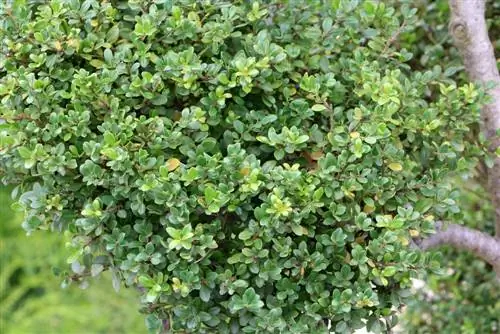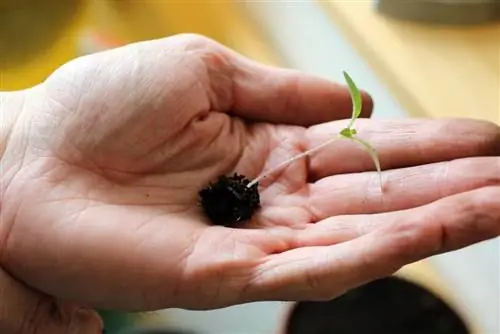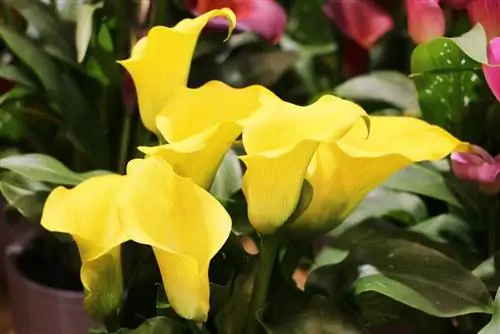- Author admin [email protected].
- Public 2023-12-17 03:39.
- Last modified 2025-01-24 12:45.
The Ilex Crenata “Dark Green” comes from Japan and is a common boxwood substitute here. This species of Ilex is particularly important in Kyushu, Honshu, Hokkaido and Shikoku and serves as a standard tree for landscape gardening, where it is usually found in a spherical, cone or pyramid shape. This variety was selected from Belgian seedlings by the Oprins tree nursery in 2000 and registered for European plant variety protection in 2007.
Growth and shape
The Ilex crenata “Dark Green” grows upright to broadly bushy and is less sparse than comparable other varieties. As long as it is not pruned, it generally grows higher than it is wide, but as it gets older it can grow more irregularly and therefore increasingly form lateral to overhanging branches. Since the Ilex has not been on the market for very long and therefore not enough is known about it, the appearance in age and the final height cannot yet be predicted, but is probably similar to that common in its species. In favorable locations, a height of up to 3.50 meters and more is possible.
The plant looks more beautiful than a hedge as a garden bonsai. The plant is a real eye-catcher. In order to achieve the growth habit, branches, twigs and shoots are repeatedly cut back. How often you need to cut depends on the growth. Some Ilex are only cut in spring, others throughout the entire growing season. When cutting, it is important to have absolutely sharp bonsai scissors so that only smooth cutting surfaces are produced. Dull cut surfaces turn brownish. The topiary should be carried out after the main shoot season. It is not allowed to cut into leafless old wood.
Size and height
This species of Ilex grows very quickly in its youth and can grow up to 25 cm per year in its first year of growth, with a good supply of water and nutrients, for example in a container or pot, even more. After several years of standing, an increase in height of up to 15 cm and in width of up to 10 cm is possible on average. Heights of between 125 cm and 150 cm have already been measured for 6-year-old plants. The cut is relatively insignificant because this species is very regenerating.
Soil and fertilization
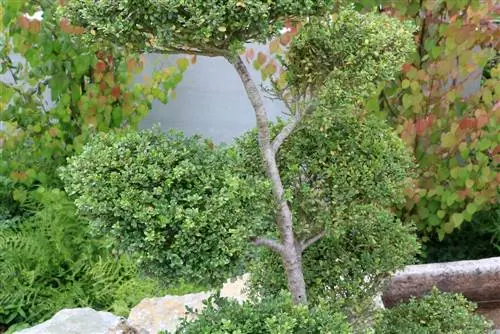
The soil should be humus and nutritious and always moist but never wet. The Ilex Crenata prefers sandy humus, gravelly humus or acidic mineral soil, but it does not like strongly loamy, clayey or slightly acidic to neutral soil. The soil should generally be well permeable so that excess water can drain away quickly and waterlogging does not occur. This should be avoided at all costs, otherwise root rot can quickly occur. However, the Ilex does not tolerate soil that is too dry, so it should be watered regularly, especially in the summer months, to prevent it from drying out. Attention should also be paid to the pH value, otherwise there is a risk of chlorosis. This is usually a sign of a lack of minerals, especially iron, magnesium, boron, sulfur or nitrogen and often indicates that the s alt content in the soil is too high.
This plant hardly needs any fertilizer at all. If you want to fertilize, it is best to use organic fertilizer from spring to autumn; this should only be used in half the concentration. In very hot weather, fertilization should be avoided completely.
Location and use
- The Ilex crenata “Dark Green” feels very comfortable in moist, warm, sunny to partially shaded locations.
- It also tolerates light shade under trees. It should always be protected from winter sun and drafts.
- The Ilex is versatile, it is particularly suitable for balconies and terraces as a pot or potted plant.
- Due to its very good pruning tolerance, “Dark Green” is also suitable as a hedge for areas protected from view or for grave borders in cemeteries.
- It also makes a beautiful bed border and can also serve as a border.
Rootball
The roots are very fine, mainly in the upper soil regions, and grow densely branched. Root growth is initially rather hesitant and opposite to the rest of the plant. The Ilex is very resistant to root pressure. To protect the roots from severe frost, a mixed layer of peat, leaves and brushwood can be applied to the root area.
Berries
- Spherical black and especially poisonous berries form in summer, which are very nice to look at.
- The berries grow up to 6 mm in size and remain on the bush for a long time.
- These berries are highly sought after by birds; in humans, consumption causes diarrhea and vomiting.
- The plant is naturally spread by birds.
Flowers
From May to June, the Ilex Crenata “Dark Green” produces small, matt white, almost inconspicuous flowers. Since this species has two pods, this species of Ilex is a female plant. However, the flowers are usually of no interest to garden owners.
leaves
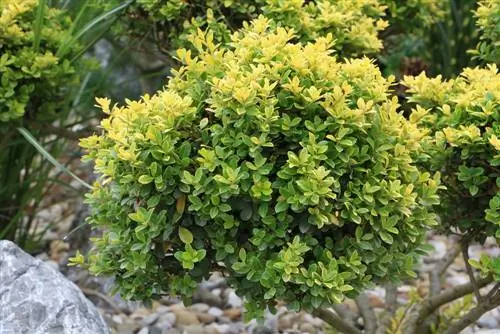
The leaves grow alternately, oval to lanceolate and generally grow up to 2 cm long in protected conditions (for example in a greenhouse or winter garden). Outdoors, the leaves only reach this size when the Ilex is a little older. The leaf color is dark green and only slightly shiny. The petiole remains short and brownish like the shoots.
Propagation
The plant is most often propagated by cuttings. In July or August after flowering, when the plant is full of sap, cuttings can be taken from the bush and simply stuck into the ground. Root formation usually takes a little longer when propagating from the left, but the young plants develop fastest after propagating from the left. The berries also contain seeds that can be used for propagation. However, it should be noted that these seeds must first be stored in a container filled with sand for a year before they are able to germinate. Natural distribution occurs through birds.
Pests
The Ilex Crenata “Dark Green” is very resistant to pests and is not affected by the dreaded boxwood fungus. However, excessive humidity can promote an infestation by the red spider. Since the bark has a bitter taste, this Ilex is well protected against being bitten by wild animals.
Editor’s Tip
The Ilex Crenata “Dark Green” is a winter-hardy plant that easily tolerates lower temperatures and likes high humidity, but is sensitive to heat and prolonged drought. This tree tolerates shade well and is resistant to root pressure. However, urban climate resistance, pest resistance, as well as high visibility and excellent formability make the Ilex interesting for garden and balcony owners.
What you should know about Ilex crenata in brief
- Ilex crenata is very versatile: the plant looks good in pots, as an underplant, in group plantings and also as a hedge.
- Ilex crenata can grow up to three meters high. At first the growth is tightly upright, later it becomes spreading.
- The Ilex is hardy, but should not be too drafty.
- The ideal soil is acidic to neutral and definitely not calcareous. It should be humic and nutritious.
- A layer of mulch has a positive effect as the roots grow tomentose in the upper soil layers.
- There are about 30 different Ilex crenata varieties. The Convexa variety is suitable as a small hedge. It sprouts vigorously again even after a strong pruning. When older, the hedge reaches a height of 3 to 4 meters. Ilex crenata Hetzii grows more widely and is only about 2 meters high. However, this variety is not quite as hardy.

